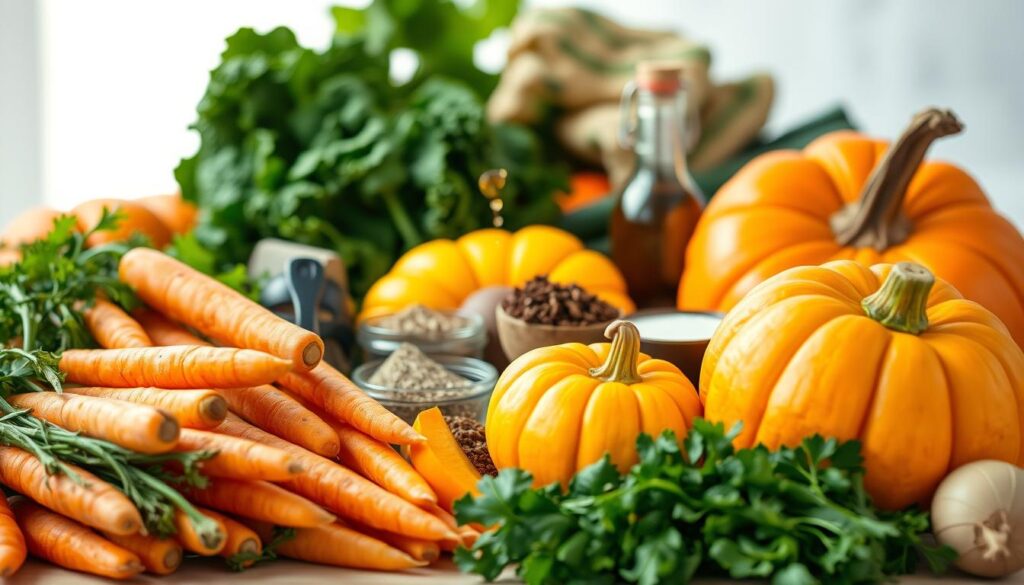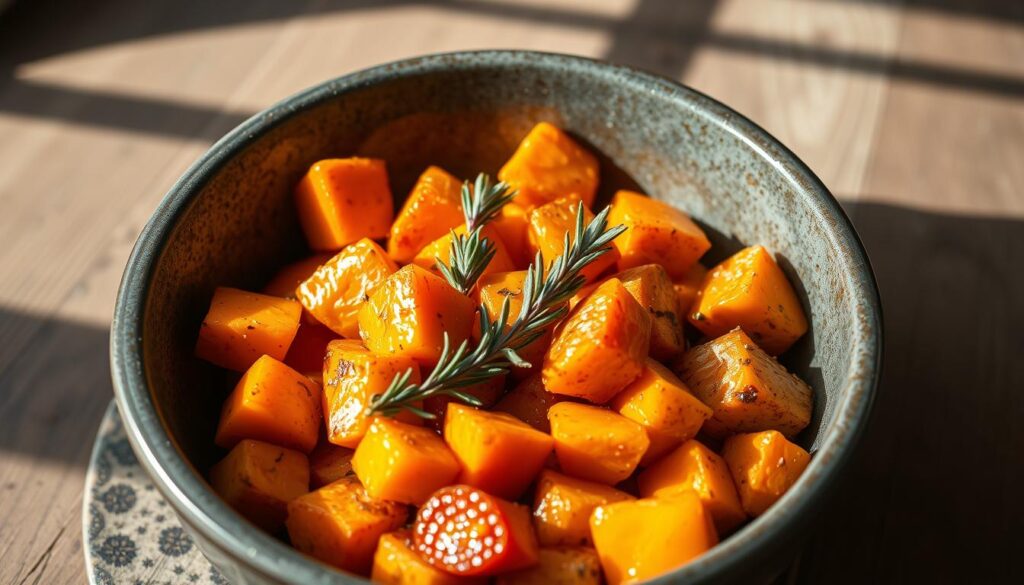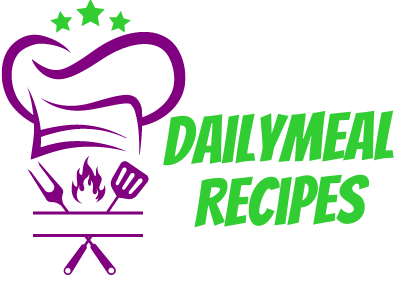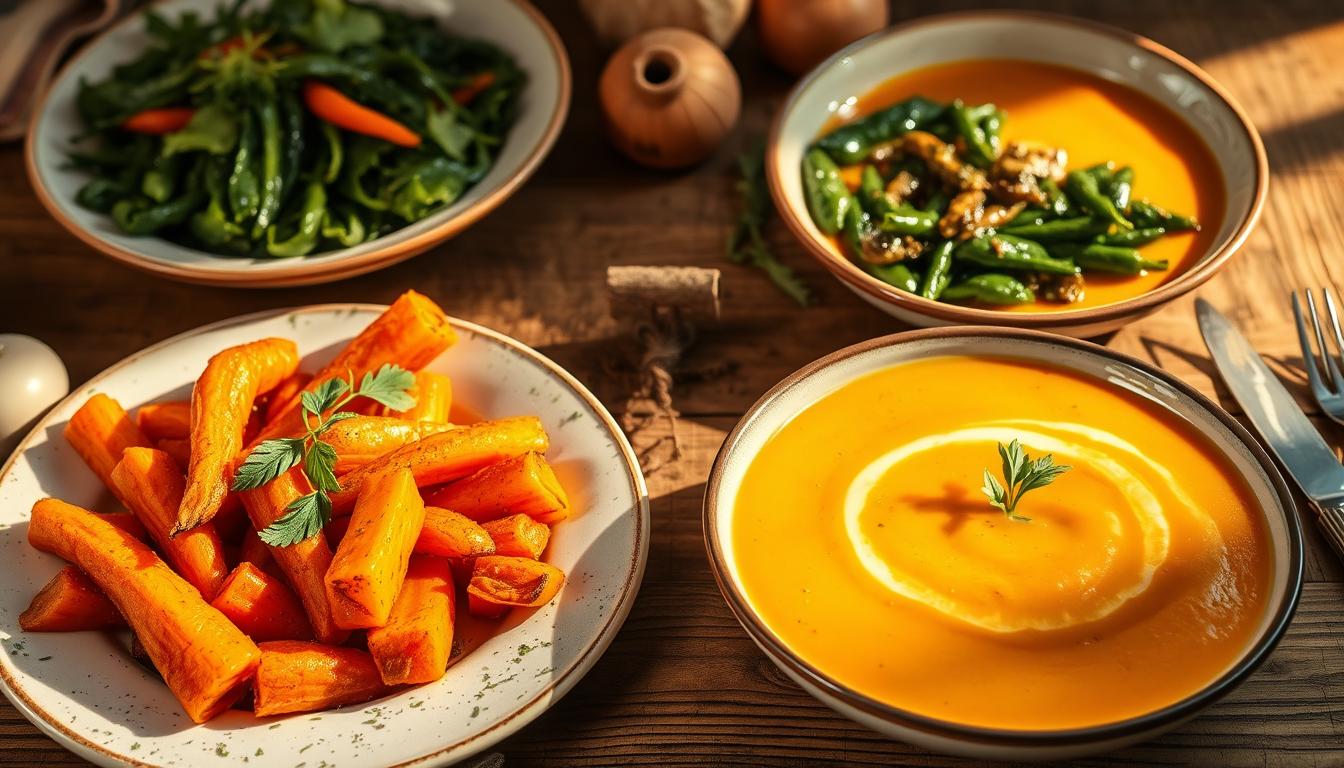As a health-conscious cook, I’ve found that vitamin A-rich foods can make meals both healthy and tasty. Your path to better health begins in the kitchen. Every meal can be a chance to improve your overall wellness.
Vitamin A is key for your body’s best performance. These dinner recipes with high vitamin A are not just yummy but also packed with nutrients. They support your vision, immune system, and help cells grow. You’ll find vibrant veggies and protein-rich foods that are both delicious and nutritious.
Get ready to try seven amazing dishes that will change your dinner game. Each recipe is designed to boost your vitamin A while offering great taste and nutrition.
Key Takeaways
- Vitamin A is essential for maintaining overall health and wellness
- Dinner recipes can be both nutritious and delicious
- Multiple food sources contribute to vitamin A intake
- Cooking methods can impact nutrient preservation
- Balanced meals support long-term health goals
Understanding Vitamin A and Its Importance in Your Diet
Vitamin A is key for your health. It helps with vision and keeps your immune system strong. Knowing how vitamin A works helps you eat right and choose the best foods.
The Role of Retinol and Beta-Carotene
Vitamin A has two main types: retinol and beta-carotene. Retinol is in animal products, and beta-carotene is in plants. Your body turns beta-carotene into active vitamin A, making it easier to get the nutrients you need.
- Retinol: Directly usable form from animal sources
- Beta-carotene: Plant-based precursor to vitamin A
- Supports eye health and immune function
Daily Recommended Intake and Benefits
The amount of vitamin A you need changes with age and gender. Adult men need 900 mcg, and women need 700 mcg.
| Gender | Daily Vitamin A Requirement | Key Benefits |
|---|---|---|
| Adult Males | 900 mcg | Bone health, vision protection |
| Adult Females | 700 mcg | Immune support, skin health |
Fat-Soluble Properties and Absorption
Vitamin A is fat-soluble, so it’s best absorbed with fats. Pairing vitamin A-rich foods with healthy fats can significantly improve nutrient uptake. Studies show eating vitamin A with olive oil or avocado helps your body absorb it better.
Pro tip: Combine carrots with a small amount of olive oil to maximize vitamin A absorption.
It’s important to get the right amount. Too much, over 1,500 mcg, can harm your bones. Talk to a doctor to find out how much vitamin A is right for you.
Essential Ingredients for Vitamin A-Rich Meals
Making meals full of vitamin A is easy. Just pick the right ingredients. Knowing animal and plant sources of vitamin A helps make tasty, healthy dinners.

Animal-Based Sources of Vitamin A
Animal products are rich in vitamin A. Here are some top choices:
- Beef liver: Contains a staggering 6,582 RAE per three-ounce serving
- King mackerel: Provides 24% of daily vitamin A needs in just six ounces
- Dairy products like whole milk and cheese
- Eggs, particularly egg yolks
Plant-Based Sources of Vitamin A
Vegetables are great for vitamin A, thanks to beta-carotene. Sweet potatoes and carrots are perfect for getting more vitamin A:
- Sweet potatoes: One medium baked potato provides over 100% of daily vitamin A
- Carrots: Packed with beta-carotene
- Butternut squash: Over 450% of Recommended Dietary Intake
- Dark leafy greens like spinach and kale
Combining Ingredients for Maximum Benefits
To get the most vitamin A, mix foods with healthy fats. Try roasted sweet potatoes with olive oil or salmon in a spinach salad.
“Eating a diverse range of colorful foods ensures you’re getting a wide spectrum of nutrients.” – Nutrition Experts
| Food Source | Vitamin A Content | % Daily Value |
|---|---|---|
| Beef Liver | 6,582 RAE | 732% |
| Sweet Potato | 1,403 mcg | 156% |
| Butternut Squash | 4,226 mcg | 470% |
| Carrots | 459 mcg | 51% |
Preparing Your Kitchen for Vitamin A-Rich Cooking
Starting with the right kitchen is key for making tasty meals full of vitamin A. Your kitchen’s setup is important for keeping vitamin A rich foods nutritious. Getting ready properly can really help keep nutrients intact.
To boost your vitamin A, focus on these kitchen must-haves:
- High-quality steaming basket for vegetable preparation
- Glass storage containers for ingredient preservation
- Digital kitchen thermometer for precise cooking temperatures
- Non-stick cookware with minimal oil requirements
Choosing the right cooking methods is crucial. Steaming and roasting are top choices for keeping vitamin A. These methods protect nutrients and add flavor to your dishes.
Storing food is also vital for vitamin A-rich meals. The FDA says to eat leftovers in 3 to 4 days. Cool food fast in wide, shallow dishes and refrigerate right away. Glass containers like Pyrex are great because they don’t absorb flavors and are safe for microwave and oven.
Pro tip: Cook at lower temperatures for shorter times. This method helps keep nutrients in your food while making it tasty and healthy.
Sweet Potato and Butternut Squash Dinner Bowl
Discover a dinner recipe packed with nutrients. It turns sweet potatoes into a vibrant, vitamin A-rich meal. This dish combines two powerful ingredients for a healthy dinner.

Preparation Tips and Techniques
To make the perfect bowl, start with fresh, firm veggies. Here’s how to prepare:
- Wash and peel both sweet potatoes and butternut squash
- Cut vegetables into 1-inch cubes for even roasting
- Preheat oven to 425°F (220°C)
- Use parchment paper to prevent sticking
Seasoning and Flavor Enhancement
Add dynamic seasonings to boost your dinner’s flavor. Try these options:
- Sprinkle smoked paprika for depth
- Add fresh thyme leaves
- Drizzle olive oil before roasting
- Season with sea salt and cracked black pepper
Storage and Reheating Instructions
Store this nutritious bowl properly to enjoy it later. It keeps in the fridge for up to 4 days in an airtight container. Reheat in a microwave or oven to keep it tasty.
Pro tip: Add a splash of vegetable broth when reheating to prevent dryness.
Nutritional highlights of this dinner bowl include:
- Total calories per serving: 327.9 kcal
- Vitamin A content: 469.1 IU
- Total carbohydrates: 66.5 g
- Protein: 3.7 g
Liver and Caramelized Onions with Herbs
Discover a powerhouse of nutrition with this delectable liver recipe. It turns an often-overlooked ingredient into a dinner recipe with high vitamin A. Beef liver is a nutritional superstar, offering 25,411 IU of vitamin A per serving.
Preparing this dish requires some strategic cooking techniques. Start by soaking the liver in buttermilk for 10-30 minutes. This step softens its robust flavor, making it more palatable and tender.
- Prep time: 15 minutes
- Cooking time: Approximately 6 minutes
- Servings: 4
Key ingredients for your liver dinner recipe include:
- 1 pound grass-fed beef liver
- 2 large yellow onions
- 3 cloves of garlic
- 2 tablespoons cooking fat (bacon fat or butter)
- Fresh herbs like thyme or rosemary
When cooking, remember that liver requires quick preparation. Sear each side for just 3 minutes to maintain its delicate texture. The internal temperature should reach 145°F for safe consumption. Pair with caramelized onions to balance the liver’s intense flavor profile.
Nutritionally, this dish is extraordinary. A single serving provides 32 grams of protein, 16 grams of fat, and an impressive array of vitamins. The vitamin A content alone meets 860% of your daily recommended intake. This makes it an exceptional choice for those seeking nutrient-dense meals.
Carrot and Ginger Soup
Explore a delightful carrots recipe that turns simple ingredients into a nutritious dinner. This Carrot and Ginger Soup is a warming, comforting meal. It’s packed with high vitamin A content in every spoonful.
Quick Preparation Method
Making this dinner recipe with high vitamin a is quick and easy. It only takes 25 minutes, ideal for busy weeknights. Here’s how to prepare it fast:
- Gather 6 cups of baby carrots or 1.5 pounds of fresh carrots
- Chop 1 medium onion for added depth of flavor
- Prepare 1½ tablespoons of fresh ginger
- Use 2 tablespoons of olive oil for sautéing
- Have 2 cups of vegetable broth ready
Nutritional Breakdown
This soup is not just tasty—it’s also a nutritional powerhouse. A single serving gives you a big vitamin A boost. This is key for healthy vision, immune function, and skin health.
| Nutrient | Per Serving |
|---|---|
| Vitamin A | 32,513 IU |
| Calories | 270 kcal |
| Protein | 4 g |
| Carbohydrates | 25 g |
Pro tip: Roasting carrots before blending intensifies the soup’s flavor and enhances nutrient absorption.
A bowl of this soup delivers more than just comfort—it’s a nutrient-rich meal supporting your overall health.
Salmon and Leafy Greens Sheet Pan Dinner
Making tasty fish recipes high in vitamin A is easy with this sheet pan salmon and leafy greens dinner. It’s a quick and healthy meal that combines salmon and fresh greens. This dish is simple yet delicious.
This sheet pan dinner is packed with nutrients and easy to clean up. It uses wild-caught salmon and leafy greens. It’s a healthy and convenient meal option.
- Preparation time: 10 minutes
- Total cooking time: 55 minutes
- Servings: 4 people
For a great fish and leafy greens recipe, you’ll need:
- 4 salmon fillets (4 ounces each)
- 4-8 cups mixed leafy greens
- 1 pound red baby potatoes
- 2 cups cherry tomatoes
- ¾ pound fresh green beans
Wild-caught salmon is best for vitamin A and omega-3 fatty acids. Cooking at 400°F keeps the salmon flaky and nutrient-rich.
“A sheet pan dinner transforms complex cooking into an effortless, nutritious experience.” – Culinary Nutrition Expert
The final dish is very nutritious:
- 550 calories per serving
- 38g protein
- 39g carbohydrates
- 27g total fat
Try drizzling your sheet pan salmon with homemade honey mustard vinaigrette. It boosts flavor and adds more nutrition.
Pumpkin and Chicken Curry
Discover a delightful pumpkin recipe that turns dinner into a mouthwatering experience. This pumpkin and chicken curry is both nutritious and delicious. It’s a meal that’s satisfying and healthy.
Pumpkin adds a nutritional boost to this curry. It’s full of beta-carotene, which turns into vitamin A in your body. The vibrant orange vegetable pairs well with tender chicken. Together, they make a dish that’s comforting and full of nutrients.
Essential Ingredients for Perfect Curry
- 1 pound boneless chicken thighs
- 2 cups fresh pumpkin, cubed
- 1 can (14 oz) coconut milk
- 3 tablespoons red curry paste
- 1 tablespoon fish sauce
Spice Blend Preparation
Creating the perfect spice blend is key for a great curry. Mix red curry paste with crushed kaffir lime leaves and a bit of brown sugar. This balances the flavors. The goal is to layer spices that enhance the pumpkin’s sweetness.
| Nutritional Value | Per Serving |
|---|---|
| Calories | 327 kcal |
| Protein | 15 g |
| Vitamin A | 5341 IU |
Cooking Process Steps
- Marinate chicken for 20 minutes
- Sauté chicken until golden brown
- Add pumpkin and coconut milk
- Simmer for 15-20 minutes
- Garnish with fresh Thai basil
Pro tip: Serve over jasmine rice to complete this vitamin A-rich dinner recipe. It will delight your taste buds and nourish your body.
“Cooking is about passion, so it may look slightly temperamental in a way that it’s too assertive to the naked eye.” – Gordon Ramsay
Beef and Sweet Potato Stew
Find a hearty dinner recipe that’s full of vitamin A. It combines beef and sweet potatoes for a taste that’s both rich and nutritious. This stew is more than just a meal; it’s a nutritional powerhouse.
Sweet potatoes are a great way to increase your vitamin intake. This stew gives you 17,583 IU of vitamin A per serving. It’s a great choice for anyone looking for a nutritious meal.
- Total cooking time: 8-10 hours on low heat
- Servings: 6 people
- Calories per serving: 486 kcal
- Protein per serving: 40 g
The recipe uses tender beef chuck roast and sweet potatoes. It’s a balanced meal that meets your daily nutritional needs. Each serving has plenty of protein, healthy fats, and vitamin A.
Nutrition highlights include:
| Nutrient | Amount per Serving |
|---|---|
| Vitamin A | 17,583 IU (352% Daily Value) |
| Protein | 40 g |
| Total Fat | 27 g |
For leftovers, store them in the fridge for up to 1 week or freeze for 3 months. This recipe is ideal for busy families who want healthy meals.
Spinach and Ricotta Stuffed Shells
Discover a delightful leafy greens recipe that turns dinner into a nutritional masterpiece. These spinach and ricotta stuffed shells are perfect for dinner recipes with high vitamin a content. They offer a delicious vegetarian meal packed with essential nutrients.
Spinach is a nutritional superstar in this recipe. One cup of fresh spinach gives you 943 mcg of vitamin A. That’s 105% of your daily recommended value. By mixing spinach with creamy ricotta, you get a meal that’s both satisfying and incredibly healthy.
- Prep time: 20 minutes
- Cook time: 30 minutes
- Servings: 4-6
- Oven temperature: 375°F (190°C)
To prepare this dish, gather these key ingredients:
- 12 jumbo pasta shells
- 1½ cups ricotta cheese
- 1 cup fresh spinach
- 2 cloves garlic
- 2 cups marinara sauce
- 1 cup mozzarella cheese
The nutritional profile of this dish is impressive. Each serving provides:
- 465 calories
- 27g protein
- 1994 IU vitamin A
- 521 mg calcium
Pro tip: Maximize vitamin A absorption by cooking your spinach lightly. Pair it with a small amount of healthy fat from the cheeses. This helps your body better utilize the nutrients in these leafy greens recipes.
Bake the stuffed shells for 25 minutes covered, then an additional 10 minutes uncovered. This will give you a golden, crispy top. Your dinner recipes with high vitamin a content have never been this delicious!
Tips for Preserving Vitamin A Content While Cooking
When cooking vitamin A rich foods, it’s important to use the right techniques. This ensures you keep as many nutrients as possible. Steaming and microwaving are great for keeping nutrients in veggies like carrots and sweet potatoes.
Keeping the temperature low is key to saving vitamin A. Avoid high heat like frying and long boiling. Instead, use gentle methods like light sautéing and quick steaming. This helps keep beta-carotene and other important nutrients.
Adding healthy fats to your dishes can also help your body absorb vitamin A better. For example, olive oil with roasted sweet potatoes or avocado in a spinach salad. Mixing raw and lightly cooked foods is the best way to get all the nutrients you need.
FAQ
What are the two main forms of vitamin A?
How much vitamin A do I need daily?
What are the best food sources of vitamin A?
How can I improve vitamin A absorption?
Can I get too much vitamin A?
Are vitamin A supplements necessary?
What are signs of vitamin A deficiency?
Can vegetarians get enough vitamin A?
What cooking methods preserve vitamin A best?
Are canned or frozen vegetables as good for vitamin A?
Try Thes Recipes Next!
if you’re looking for more delicious recipes, check out our guide for another
crowed-pleasing dish

